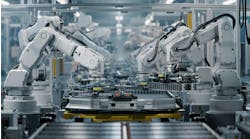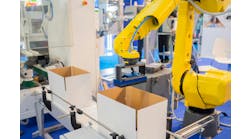As manufacturers of all types plan, define and commission machine automation on the plant floor, there are many things to consider. Not only must the machines hit the ground running after the factory acceptance test, but they should be simple to support now and in the future. Changes in personnel and product requirements will demand it.
To ensure machines meet productivity, performance and quality requirements, there are some key things the machine builders, integrators and/or end users need to know about selecting, integrating and commissioning robotic and automation systems. Both machine builders and suppliers are aware of this, and they provided some examples.
“We are using Augmented Reality for Remote Support presently—this this has the potential to be a game changer as it lowers the need for technical resources on both sides of the support equation,” says Craig A. Souser, president/CEO of J.L. Souser & Associates, Inc. (JLS) in York, Pennsylvania. “As part of our Next Gen machines, we have worked hard to make the system simpler, not just from a hardware perspective, but also ease of use. We have eliminated a teach pendant, typical for a robot-controller-based system, and now, everything is on the HMI. We have greatly reduced the amount of programming that our guys do in configuring a system, which not only streamlines the process and eliminates coding errors, but it allows our customer with the appropriate training to do much more on their own in areas like adding recipes or making some basic changes.”
Simpler hardware, development and operation have worked for JLS as it has gone through rapid growth. New automation personnel have not had to learn how to program robots in the traditional sense. The hardware and programming architecture already exist and Souser estimates it cuts the learning curve for basic machines and applications in half.
As an end user selecting an integrator to provide the services, the customer needs to do a good deal of vetting. “Is the potential provider truly capable of this project?” asks Souser. “Do they do any field testing or validation of tooling or motion simulations to address needs? What is their support capacity? We have seen many projects go to the ‘newbie’ that has underpriced a system, stumbled badly, spent months trying to figure it out while the customer’s production suffers. The result is the system gets put in a bone yard. It’s painful when we hear those stories, and it can set automation back years.”
The machine control systems are one of the keys to keeping things supportable and simple, and the use of a PLC can lead the way. “PLC-centric integration simplifies control of motion and reduces intimation of the end user while easing long-term support of an integrator-designed robotic machine,” says Chris Elston, chief robotics manager at YRG, a master distributor of Yamaha Robots. "The fancier the control system is, the harder it is for technicians to keep up and be trained on how to keep a new automation line running in the manufacturing world.”
Part of a simpler machine is that robots are getting smarter. “Firmware updates to robot controllers include enhancements that start to predict arm motor overload conditions, for example,” says Elston. "Robot controllers can now alert maintenance personnel ahead of time via email or text message when a joint in a robot is experiencing increased amperage load. This condition normally indicates some kind of a mechanical resistance or lack of lubrication that could lead to downtime if not looked at, so robot control systems with built-in predictive maintenance features that can tie into a cloud system or an IoT are realistic trends and features manufacturing engineers should invest in now with increasing robot life expectancies on the rise."
Epson is very bullish on the introductory education of robotic automation to new users. "We're finding there is a lot of interest in this topic, says Scott Marsic, product manager for Epson Robots. “Automation has always been a buzz word within manufacturing, and yet at a baseline we always want our customers to really ask themselves, ‘Why do I want to automate?’ and ‘What am I looking to achieve by automating?’
Once these questions are understood, there is an entire network of distributors and system integrators who can help customers better understand their current manufacturing processes, associated automation requirements and then potential solutions. This is important to know, especially if a company does not have the experience or internal support to design and implement an automation program themselves.”
For those looking to dip their toes in the water—so to speak—integrators, Epson and most other robotic manufacturers offer solutions that are not only affordable but are also easy to implement with fully integrated peripheral solutions such as vision and flexible feeding.
Robotic systems and automation, whether developed in-house or implemented by a third party, can overwhelm end users. Just remember, it’s not about the robot alone—it’s about the system that the robot works within and the ways to make the application and development easier.






